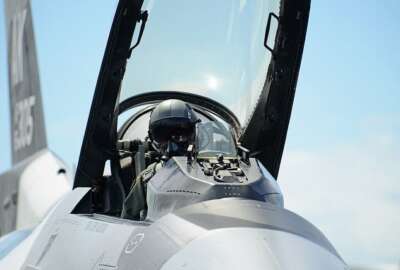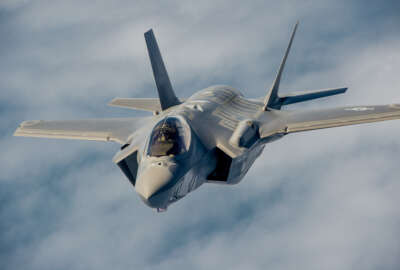
Air Force expands futuristic training to maintainers
The Air Force is creating a maintainer training program to follow in the footsteps of the Pilot Training Next program, now in it's second stint.
Best listening experience is on Chrome, Firefox or Safari. Subscribe to Federal Drive’s daily audio interviews on Apple Podcasts or PodcastOne.
The Air Force is expanding its futuristic training environment this year to enhance and speed up the education of those who maintain aircraft and other weapons.
The service is creating a Maintainer Training Next program, based off of the Pilot Training Next program, which is now entering its second year, said Brig. Gen. Jim Sears, director of plans programs and requirements for Air Education and Training Command.
“It’s really focused on the nonflying training that we do at Air Education and Training Command,” Sears said in an interview. “It’s going to be able to use the same technology and develop the same techniques and all the other things about feedback and time and putting students in charge of their training.”
The Pilot Training Next program gives pilot trainees their own flight simulators to work with at home so they are able to practice flying at any time. The program uses sensors to take in biometric data, such as eye movements and heart rate, to analyze and then form better ways of training pilots in the air and on the ground. The service hopes to expand the program to other areas outside of pilots and maintainers in the in the near future.
Related Stories
The Air Force plans to use the same technologies and tactics for maintainers starting this summer. The program might take into account when maintainers’ heart rate increases during a task. Trainers can use that data to find out what parts of a task are harder and more stressful and then put more focus on those areas.
“We are thinking we should be able to use much of the technology we’ve been using with the Pilot Training Next,” Sears said. “The important thing would be to take those things that we learned, including how you can use virtual and augmented reality to accelerate and enhance and make the training people have last longer and have more resilience. At the same time, we want to use artificial intelligence tutors and big data to see how the students are receiving the training techniques and how they are progressing and then accelerate their training and move them through faster.”
Pilot and Maintainer Next gives instructors the ability to have multiple students working on multiple tasks at the same time.
Sears said that is truly “macro-innovation,” which will be able to save time, effort and money for the Air Force.
The need for maintainers
Pilots and maintainers are two of the most in-demand positions in the Air Force. The service is working with a 2,000-pilot deficit. The service was previously down 4,000 maintainers, but has since closed that gap by prioritizing maintainers as the force grew over the past couple years. The biggest challenge with maintainers now is they lack experience. While the positions may be filled, they are not filled with the veterans needed to work on certain complex systems or oversee other maintainers.
“It’s almost like squeezing the balloon and what happens on the other end; we are going to have a lot of inexperienced workforce, we’re going to have many recently graduated high school students working on our fighter planes and we take that very seriously to make sure we get them trained correctly so they become experts eventually,” Lt. Gen. John Cooper, deputy chief of staff for logistics, engineering and force protection, explained in 2017.
Sears hopes the new ways of training maintainers can speed up that process.
There was an “increase of lower-level maintainers over the last two years as we ramped up production,” Sears said. “We’ll be able to use those educational techniques to get those airmen out in the field and trained better.”
That’s especially important right now because the Air Force is feeling pressure from the Defense Department to get its aircraft into shape. The Pentagon challenged all of the military services to raise their fighter jets to 80 percent readiness. That means more demand for maintainers.
A few kinks to work out
When the first iteration of Pilot Training Next finished last summer, the Air Force said it fell short on how it would actually use the data it collected.
“That’s one of the more challenging things,” said Scott Van de Water, deputy director of Pilot Training Next at Air Education and Training Command. “Where we see this going in the medium term is having a little bit more data analytic capacity. But, in order to do data analytics you need to have robust data sets and you need to be able to dissect those data sets and make sense of them in a meaningful way. We need to spend a lot of time looking at how to understand the data we are gathering in order to make sure the conclusions we are drawing are valid and in order to make those decisions based on solid ground.”
It’s one thing to collect data, but use it meaningfully is a different story.
Sears said the program used the six months between programs to work out those kinks.
“They didn’t do that very well the first time,” Sears said. “Collecting data is hard and then actually being able to analyze data and collect the data to be able to analyze it is very hard.”
Sears said the program worked on characterizing data so it can be better read by artificial intelligence.
“One of the most complicated things is that biometric data to assess performance and stress and how the body is reacting is very important,” Sears said. “They are also going to take a deeper look into how the students are resting, how their bodies react while they’re studying, what they’re doing in their off-time to truly get a more holistic look at the entire day for the students so we can tailor the training and design future training.”
Copyright © 2024 Federal News Network. All rights reserved. This website is not intended for users located within the European Economic Area.
Scott Maucione is a defense reporter for Federal News Network and reports on human capital, workforce and the Defense Department at-large.
Follow @smaucioneWFED





